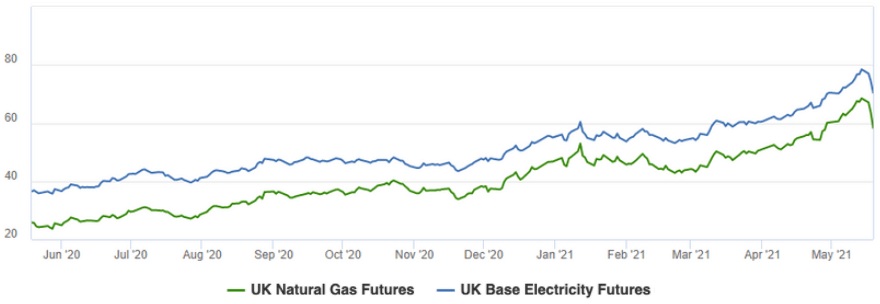Energy Market Updates
An increase in oil prices, a rise in household gas and electricity bills, and higher clothing prices have pushed the annual rate of UK inflation to 1.5% in April from 0.7% in March, its highest level since the start of the pandemic.
Pent-up demand but equally a return to more normal pricing for fuels and other household utility costs appear to be driving the rise, which could lead to higher interest rates in the coming quarters.

An increase in oil prices, a rise in household gas and electricity bills, and higher clothing prices have pushed the annual rate of UK inflation to 1.5% in April from 0.7% in March, its highest level since the start of the pandemic. Pent-up demand but equally a return to more normal pricing for fuels and other household utility costs appear to be driving the rise, which could lead to higher interest rates in the coming quarters.
Despite current inflation worries, European stocks have bounced back thanks to reopening optimism and solid corporate earnings, with the FTSE trading at 6,975 points and the EURO STOXX 50 at 3,970 points. Globally, stock markets have been struggling for traction in the past week after minutes from the U.S. Federal Reserve revealed some officials would have discussed adjusting the pace of asset purchases.
Oil prices have fallen for a third day today, with Brent front-month currently at $65.90 per barrel, following talks between the European Union, the United States and Iran over Tehran’s nuclear programme, which could result in sanctions being lifted and a possible return of Iranian supply.
Rising Covid infections in Asia and an increase in U.S. crude oil inventories of 1.3 million barrels, as reported yesterday, also added pressure to oil prices. Meanwhile, U.S. gasoline and distillate stocks dropped both more than expected, after a ransomware attack on the nation’s largest fuel pipeline ran down supplies last week.
Gas and Power
Short-term prices have been very volatile this week, day-ahead gas reached 71.00 pence per therm (ppt) on Friday (down to 59.00 ppt this morning) while power traded at £85.00/MWh on Monday before coming down to £60.50/MWh today thanks to a large (but brief) increase in wind generation levels.
In the last couple of days Asian LNG prices have come down together with oil and European gas prices, however, the decrease has been much smaller than on the European side. The price difference between the two regions has therefore widened to around 10 ppt, pointing towards low LNG deliveries in the coming weeks.
EU carbon prices made new highs on Friday with the December 21 contract trading at €56.90/tonne. They have weakened since then, following oil, equities and gas down and possibly pushed lower by sales from UK participants gradually replacing their hedges with UK allowances.
The UK sold its first tranche of carbon allowances at auction yesterday at a price of £43.99/tonne, while UK Allowances (UKAs) futures have started trading on ICE. The December 21 contract has risen since the auction and is currently trading at £47.25, around £3 higher than the EU’s December 21 contract.
Long-term gas prices fell sharply yesterday thanks to lower short-term prices and after reports that Nordstream 2 (a gas pipeline between Russia and Germany) could come online earlier than previously thought. Lower equities, oil and carbon also helped, power followed with W21 closing at £75.50, a £9 drop from Friday’s high. Current levels are a buying opportunity, especially for power due to the strong outlook for carbon markets.
Find out how Meercat can lower your energy bills.
